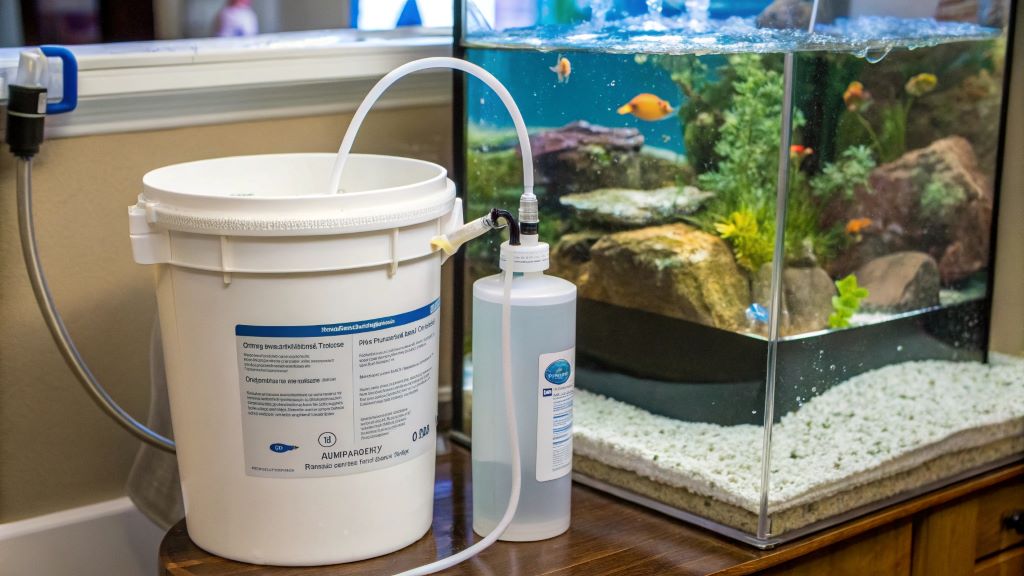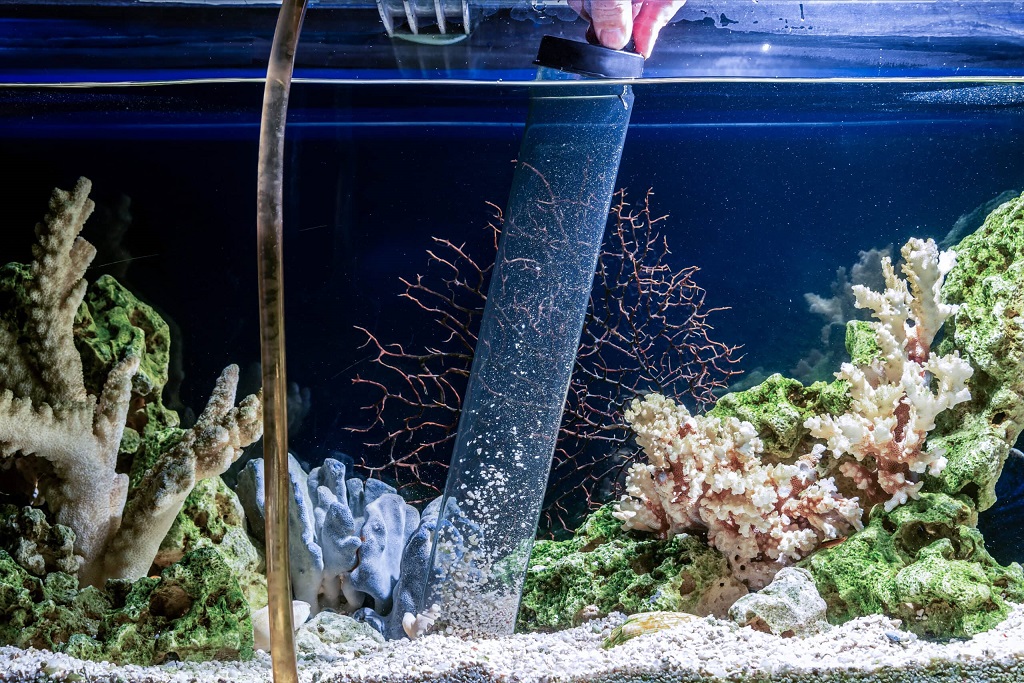Introduction
Maintaining a healthy and thriving aquarium environment is crucial for the well-being of your aquatic pets. Regular water changes are a fundamental aspect of aquarium maintenance, as they help to remove accumulated waste products, replenish essential minerals, and maintain optimal water quality. While there are various sources of water suitable for aquarium use, tap water remains the most readily available option for many aquarists. However, tap water often contains chlorine and chloramine, chemicals added to disinfect the water supply, which can be harmful to fish and other aquatic life. This is where dechlorination comes in. Using dechlorinated tap water for aquarium water changes ensures that these harmful substances are neutralized, providing a safe and stable environment for your aquatic inhabitants.
Dechlorination is the process of removing chlorine and chloramine from tap water, making it safe for aquarium use. There are several methods for dechlorinating water, each with its own pros and cons. In this comprehensive guide, we will explore the use of dechlorinated tap water for aquarium water changes, discuss the various dechlorination methods, weigh the pros and cons, and answer some frequently asked questions.
Understanding Chlorine and Chloramine
Chlorine and chloramine are commonly used disinfectants in municipal water treatment. Chlorine is a highly effective disinfectant that readily reacts with organic matter in water, forming harmful byproducts. Chloramine, a combination of chlorine and ammonia, is a more stable disinfectant with a longer residual effect. While these chemicals are essential for ensuring safe drinking water, they can pose serious risks to aquatic life.
Chlorine and chloramine can damage the delicate gills of fish, impairing their ability to breathe. They can also disrupt the biological filtration in your aquarium, leading to ammonia and nitrite spikes, which are toxic to fish. Additionally, these chemicals can harm beneficial bacteria and other microorganisms that play a vital role in maintaining a healthy aquarium ecosystem.
Dechlorination Methods
Several methods are available for dechlorinating tap water, each with its own advantages and disadvantages.
-
Chemical Dechlorination
Chemical dechlorinators are readily available at most pet stores and online retailers. These products typically contain sodium thiosulfate, which neutralizes chlorine and chloramine. Chemical dechlorinators are easy to use and highly effective, making them a popular choice among aquarists.
Pros:
- Convenience: Chemical dechlorinators are readily available and easy to use.
- Effectiveness: They effectively neutralize chlorine and chloramine.
- Affordability: Chemical dechlorinators are generally inexpensive.
Cons:
- Overdosing: Overdosing can lead to adverse effects on fish and other aquatic life.
- Chemical Residues: Some dechlorinators may leave behind chemical residues in the water.
- Environmental Impact: The production and disposal of chemical dechlorinators can have an environmental impact.
-
Carbon Filtration
Activated carbon filters can effectively remove chlorine and chloramine from tap water. These filters contain activated carbon granules, which adsorb chlorine and chloramine molecules from the water. Carbon filtration is a popular choice for aquarists who prefer a more natural approach to dechlorination.
Pros:
- Natural Approach: Carbon filtration is a more natural method of dechlorination.
- No Chemical Residues: Carbon filters do not leave behind any chemical residues in the water.
- Additional Benefits: Carbon filters can also remove other impurities from the water, such as heavy metals and organic compounds.
Cons:
- Maintenance: Carbon filters require regular replacement to maintain their effectiveness.
- Cost: Carbon filters can be more expensive than chemical dechlorinators.
- Limited Capacity: Carbon filters have a limited capacity for removing chlorine and chloramine.
-
Boiling
Boiling tap water for an extended period can effectively remove chlorine. However, this method is not effective for removing chloramine, as it requires a much higher boiling point. Boiling is a less common method for dechlorinating aquarium water due to its energy consumption and potential risks.
Pros:
- No Chemicals: Boiling does not involve the use of any chemicals.
- Readily Available: Boiling water is a readily available method for dechlorination.
Cons:
- Ineffective for Chloramine: Boiling is not effective for removing chloramine.
- Energy Consumption: Boiling water can be energy-intensive.
- Safety Risks: Boiling water can pose safety risks if not handled carefully.
-
Aging
Aging tap water in an open container for 24-48 hours can allow chlorine to naturally evaporate. However, this method is not effective for removing chloramine, as it is more stable and less volatile than chlorine. Aging is a less reliable method for dechlorinating aquarium water and is generally not recommended.
Pros:
- No Chemicals: Aging does not involve the use of any chemicals.
- Simple: Aging water is a simple method for dechlorination.
Cons:
- Ineffective for Chloramine: Aging is not effective for removing chloramine.
- Time-Consuming: Aging water can be time-consuming.
- Unreliable: The effectiveness of aging can vary depending on factors such as temperature and humidity.
Pros and Cons of Using Dechlorinated Tap Water

Using dechlorinated tap water for aquarium water changes offers several advantages and disadvantages.
Pros:
- Readily Available: Tap water is readily available in most households.
- Cost-Effective: Tap water is generally less expensive than other sources of aquarium water.
- Consistent Quality: Tap water typically has a consistent quality, unlike some natural sources.
- Convenience: Dechlorinating tap water is a convenient way to obtain aquarium water.
Cons:
- Chemical Contamination: Tap water may contain other contaminants, such as heavy metals and pesticides, which can be harmful to aquatic life.
- pH and Hardness: The pH and hardness of tap water can vary depending on the source, which may require additional adjustments for certain aquarium setups.
- Dechlorination Process: Dechlorinating tap water requires an additional step in the water change process.
Reviews
Many aquarists successfully use dechlorinated tap water for their aquariums. However, it is essential to choose a reliable dechlorination method and monitor water parameters regularly to ensure the health and well-being of your aquatic pets. Some aquarists prefer using alternative water sources, such as rainwater or reverse osmosis water, due to concerns about potential contaminants in tap water.
Popular FAQs
-
Can I use bottled water for my aquarium?
Bottled water is generally not recommended for aquariums, as it may contain minerals and additives that can be harmful to aquatic life. Additionally, bottled water can be expensive and unsustainable.
-
How often should I change the water in my aquarium?
The frequency of water changes depends on several factors, such as the size of the aquarium, the number of fish, and the type of filtration system. As a general rule, it is recommended to change 10-20% of the water in your aquarium every 1-2 weeks.
-
What is the ideal pH for my aquarium?
The ideal pH for your aquarium depends on the type of fish and other aquatic life you are keeping. Most freshwater fish thrive in a pH range of 6.5-7.5.
-
How can I test the water quality in my aquarium?
You can test the water quality in your aquarium using a variety of test kits, which are available at most pet stores and online retailers. These kits can measure parameters such as pH, ammonia, nitrite, nitrate, and hardness.
-
What should I do if I accidentally overdose on dechlorinator?
If you accidentally overdose on dechlorinator, perform a partial water change immediately to dilute the concentration. You can also use a chemical filter media, such as activated carbon, to remove excess dechlorinator from the water.
Conclusion
Dechlorinated tap water can be a safe and effective source of water for aquarium water changes, provided that you choose a reliable dechlorination method and monitor water parameters regularly. Chemical dechlorinators, carbon filtration, and boiling are some of the common methods for dechlorinating tap water. Each method has its own pros and cons, and the best choice for you will depend on your individual needs and preferences.
Remember, maintaining optimal water quality is essential for the health and well-being of your aquatic pets. By understanding the importance of dechlorination and choosing the right method for your aquarium, you can ensure a thriving and vibrant aquatic environment.
Read More:
Aquarium Cleaning for Beginners: A Step-by-Step Guide, Pros and Cons, Reviews, and FAQs
Reef Tank Live Rock: The Living Foundation of Your Reef Tank




